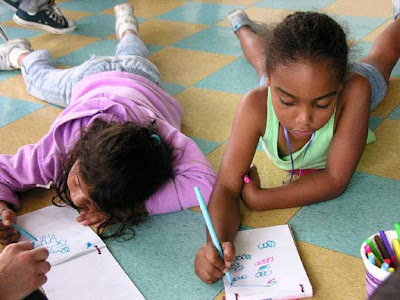How was the project conceived and what are the Library’s goals?
Anne: The Library wanted to create an interactive early literacy environment that would be accessible to everyone and become a destination for children and families in Rhode Island. We took inspiration from the Baltimore Public Library’s early childhood area.
Why was Providence Children's Museum interested in this project? What are the benefits of this collaboration between two community institutions?
Janice: Partly because creating interactive learning environments for children and families is what we do. Second, because it’s the library. We’re colleagues, we share resources and always have – we’re partners in the world of informal learning so it seemed pretty natural. The Museum is committed to outreach – going beyond our walls and sharing our expertise in informal learning and environments is part of our strategic plan. It was definitely a big leap but it was intriguing and it felt right to try it.
Anne: The Library has three pieces to our strategic plan and one is early childhood. To be able to stretch our boundaries a bit and bring in an interactive environment was something we really wanted to do and a natural partnership. The Museum’s staff are the experts in the field and we do have this ongoing and very strong collegial relationship. Collaborating is the way to bring these kinds of experiences to children and their families.
Janice: We want families to understand that their libraries and museums and parks and playgrounds and zoos are resources in a community for them to make use of. That’s what makes a culturally aware citizen.
Anne: It builds a sense of community. So many children are in isolation much of the time – it’s important for them to be out and able to just play.
Janice: Especially in places meant for them that are respectful and beautiful and thoughtful.
Robin: Topically, there’s a nice connection for the Museum because we have book nooks in all of our exhibits and we bring books into what we do but we don’t teach literacy. Partnering with the Library, where it’s about books and literacy and giving families those supports is something that we don’t really do in the same way at the Museum.
 |
| Janice's grandson reading in a book nook at the Children's Museum. |
Anne: And we’ve said all along we’re not trying to be the Children’s Museum. We complement one another.
Why was Providence Children's Museum’s proposal selected?
Anne: Because of the obvious thought and time that went into every detail. They kept our focus, learning objectives and components, and mission at the forefront of everything they did to the minutest detail. It was the finest caliber that we could have imagined and there really wasn’t any question.
Talk about the process of planning for this new space.
Anne: Putting the RFP together, the process was to think about the goals and objectives of this space. What did we want it to look like, to sound like, how do we want people to feel when they come in to the room?
Janice: The library’s RFP was excellent – it was such a thoughtful document. There’s so much work that goes into defining goals and purpose and audience. It was fun and exciting and a challenge to respond to but we didn’t have to guess what the Library wanted.
Robin: There were some design challenges for us, being the first project we’ve done outside the Museum. We’re used to designing and fabricating for a space we know incredibly well, so we found ourselves coming over a lot to check things or to measure again and again. And we had to remind ourselves throughout that the space was primarily about books, and all of the other activities were meant to support storymaking and literacy and preliteracy skills.
What’s the story of the birch tree?
Janice: We knew we needed an open-ended area for pretend play. Since so many children’s stories happen in the woods, we decided on a forest. We wanted it be a birch forest and to use real birch trees as a unifying design theme. We did some woodland scavenging with no luck and then the hurricane hit and took out one of the birch trees in the Museum’s Children’s Garden. So the tree that welcomed children to The Children’s Garden will now welcome them to the Children’s Discovery Library.
 |
| Removing the birch tree from The Children's Garden, post hurricane last August. |
What’s your vision for this space? What do you hope to see once it’s open?
Robin: I’m really excited to see kids and families in the space and to see how it changes. I hope there is more storymaking and storytelling and that some of the things we built inspire kids to go back into the books.
Anne: That it will give parents or caregivers and children more time together without distractions, to read a book, do an activity, tell a story. Just to spend some quality time together – quietly, creatively, imaginatively – and have some fun. That doesn’t always happen in this wired world we live in. And I hope that people who haven’t been to the Library before will come.
Janice: My vision is that visitors to the Library will see play as a literacy activity. That children’s play – especially pretend play, storymaking – does build literacy skills. It’s often dismissed as frivolous and it isn’t. It’s critical.
 |
| Anne, Robin and Janice reading in the Children's Discovery Library. |








































